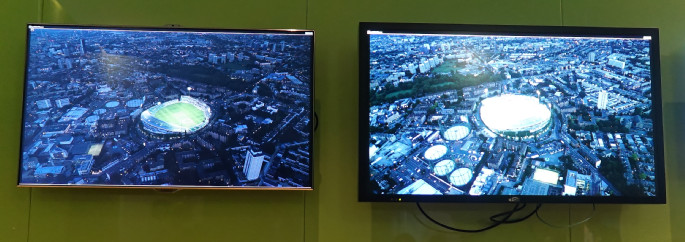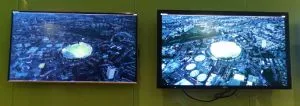We attended a “breakout” session on HDR.
Matthew Goldman and Mark Horton of Ericsson covered the general reasons and rationale for HDR as well as the work that we reported on that resulted in them winning a best paper award at NAB.
Horton started with a demo on a Sim 2 monitor (so 4,000 cd/m2 of peak brightness) showing content filmed from above a city – it looked like London at twilight. A sports stadium with bright floodlights showed the impact of HDR content. Ericsson has been working on UltraHD in all its aspects for around three years so far and Horton said that the firm has conducted 70 tests worldwide of UltraHD with tests of cameras, bandwidths, compression etc.
 Ericsson HDR demonstration used a Sim 2 display with 4k cd/m2
Ericsson HDR demonstration used a Sim 2 display with 4k cd/m2
The point of the demonstration was to show that FullHD and HDR give a more compelling experience, at typical viewing distances, than 3840 x 2160 content with high spatial resolution.
The demo was filmed using standard cameras and techniques, but with the 10 bit grey scale preserved through the production and editing process. Horton said that the important thing is that HDR is not difficult or complicated to do.
There are voices around that say that “4K is stupid” and Ericsson believes that there is a bigger “bang per buck” by improving grey scaling and dynamic range. By differentiating different grey levels more accurately, HDR effectively provides more information so it can be said to increase the resolution. The same argument applies to increasing colour gamuts.
Moving to UltraHD for TV also has significant implications for content creation. If you use a bigger screen to take advantage of the extra pixels, you can have problems if the viewer gets more immersed. You have to avoid fast camera movements and cuts. Camera changes also have to be made to capture UltraHD well.
To really change the viewing experience, you need HDR and WCG + at least 10 bit of grey scale and these all need to come together together in Ericsson’s view.
High Frame Rates (HFR) are also important as you go to larger displays with higher resolution. 4K needs at least 50/60 fps and 100 or 120 is better. For some applications even that may not be enough. In the movie business, camera angles and choice and limiting depth of field are techniques that are used to disguise problems from the low frame rate of film acquisition. These are not appropriate with sports and other “live action” content.
Ericsson also pointed out that 12G SDI is the current state of the art in digital content distribution in studios, but this will not support UltraHD.

